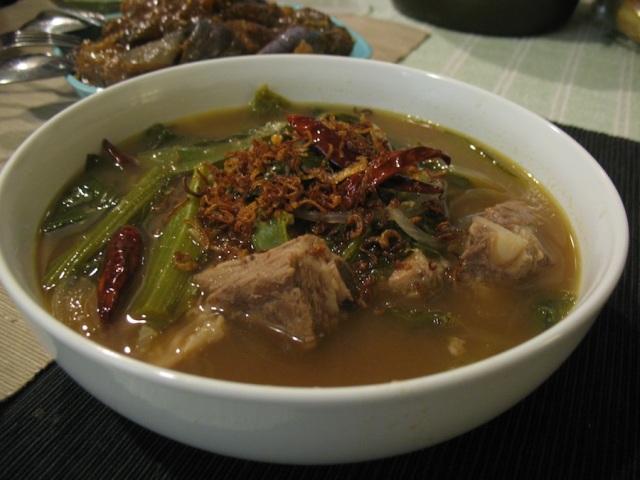I am back in Philly after a fulfilling two-week visit to Ulaanbaatar, Mongolia. More posts are still to come on Ulaanbaatar/Mongolia food themes, but for now it is time to return to Philadelphia-based posts.
After coming back to the states, it was time to go shopping for Southeast Asian home-style ingredients. I went down to 7th street’s Friendly Market and happily found something I haven’t yet seen before in the US: “rotten bean” sheets (tua nao ถั่วเน่า/ຖັ່ວເນັ່າ) from Northern Thailand.

tua nao ถั่วเน่า found! Gusto Brand from 7th St’s Friendly Market. Packaging in English, Burmese ရှမ်းပဲ ပုတ်ပြား, and Lao ຖັ່ວເນັ່າ
Like many items at Friendly Market, this item is likely primarily geared towards Burmese audience, but of course, many flavors are regional and cross-border. Northern Laos and Northern Thailand share a love of this unique food. This is a fermented soy bean product similar in make to the perhaps better-known Japanese natto 納豆.
This version of tua nao is a little bigger than the kind we brought back from Northern Thailand last time we were there. Here is an image of that package, and a size comparison between the two kinds:
You can see that the size, color, and consistency is a little bit different.
Thaifoodmaster blog has a nice introduction to this ingredient. Check out that post here.
What kinds of things can you make with this? So far, my repertoire is limited with this, but I know how to make a delicious soup with it. The soup is a favorite in Northern Thailand, and it is called jau phakgaad จอผักกาด “boiled greens”.
Andy Ricker’s recent Pok Pok cookbook has a good version of this recipe, called “Jaw Phak Kat” (by the way that whole book is excellent), although he assumes this tua nao ingredient unavailable in the US and suggests replacing it with Thai yellow bean sauce (see here for a blog post on that item from shesimmers. You can also find this recipe online from Thai sources. This is a nice step-by-step from Chiang Mai University.
Recipe: Jau phakgaad จอผักกาด “boiled greens”
This soup is straightforward enough. The only hard part is preparing the ingredients. The soup paste should be pounded first, and then the bean sheets need to be toasted and pounded. Otherwise it’s a simple boil.
Ingredients:
- About 12 Thai dried chiles (6 for the paste and 6 for the end)
- About 8 cloves of garlic
- About 8 Asian shallots (of those 3 shallots for the crispy topping)
- 1 T kapi (Thai fermented shrimp paste)
- 2 lbs pork spare ribs, cut into individual ribs
- 3/4 cup tamarind water
- 1 sheet tua nao
- 1 lb green leafy veg, usually Cantonese-style yu choy 油菜 is used, I used a gai choy 芥菜 more bitter mustard green
- 1/4 thinly-sliced yellow onion
- water
- salt
- fish sauce
Procedure:
1. Mash the paste, peppers, about 1 T salt, garlic, shallots, kapi.
2. Cover spare ribs with water and bring to boil. Skim the scum off and reduce to low heat. Add paste. Simmer for about 40 minutes, or until meat is tender. Taste for saltiness, should be salty–add salt if it is not.
3. While ribs are simmering prepare fried crunchy shallots for topping. Take the remaining shallots and slice them as thinly as possible. Heat about 4 T of vegetable oil in a small pot. This is not a simple fry on high flame. Care must be used to fry these on very low heat over about 15 minutes. The result should be golden, dry, crispy shallots. My solution to not burning them was to use a heat diffuser under my pot on low heat. When the shallots are golden, strain them and lay on a paper towel. Set aside.
4. lightly toast bean sheets over a flame (ideally wood fire coal). The color will change a little. Break up the sheet and pound to a powder. Bring heat back up and add this into the soup.
5. Prepare tamarind water, chop vegetables into 2″ lengths and wash, cut onion.
6. Add in the vegetables and onions, along with the strained tamarind water. Add in remaining whole chiles.
7. Bring heat back down and simmer for 10 minutes or until the veg is just cooked. Taste for seasoning. If not enough flavor-saltiness, add fish sauce.
8. Take off heat and top with crunchy fried shallots.
Eat together with steamed white rice or sticky rice.












Pingback: Thai fermented soy beans and sweet coconut and pork dip | Asian Markets of Philadelphia
Pingback: Sticky rice, a food staple and a key ingredient in Lao-Thai cooking | Asian Markets of Philadelphia
Pingback: Yanang leaves and Lao bamboo soup | Asian Markets of Philadelphia
Pingback: Dried ngiu flowers and a Northern Thai spicy noodle soup | Asian Markets of Philadelphia
Pingback: Sour krasang fruit for Cambodian soups and dips | Asian Markets of Philadelphia
Pingback: Yibin yacai in Sichuan-style stir fry dishes | Asian Markets of Philadelphia
Pingback: Delicious greens: yuchoy | Asian Markets of Philadelphia
Pingback: Gundruk: an essential food staple and flavor in Nepali cooking | Asian Markets of Philadelphia